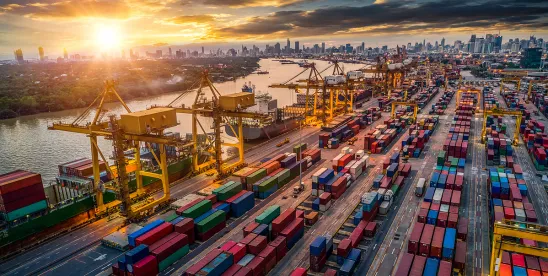This edition offers critical insights for industries including AI, Metaverse & Blockchain, Automotive, Consumer Products, Electric Mobility, Electronics, Energy & Cleantech, Fashion & Retail, Life Sciences, as well as Foreign Investors, Compliance Professionals, and Customs Brokers.
In this June 2024 edition, we cover:
1. USTR’s request for comments on proposed Section 301 tariff increases and exclusions.
2. The US Senate Finance Committee’s forced labor report on the automotive supply chain and new UFLPA Entity List additions.
3. CBP's recent country of origin ruling on Whirlpool disposers.
4. CBP's enforcement of de minimis shipments and its impact on Chinese imports.
5. The latest on the AD/CVD investigation on aluminum extrusions and how to participate in those proceedings.
6. President Joe Biden’s order requiring a crypto miner to divest real estate near a US Air Force Base.
7. What to expect under the USMCA six-year review.
1. Reminder: Section 301 Modification and Exclusion Comments Are Due by June 28
As we previously reported, the Office of the US Trade Representative (USTR) issued a Federal Register notice proposing to increase certain existing tariffs on imports from China under Section 301. As part of its proposed modifications, the USTR also announced proposed exclusions for certain solar manufacturing equipment classified in Harmonized Tariff Schedule (HTS) subheadings 8486.10.0000, 8486.20.0000, and 8486.40.0030, as well as opening a limited exclusion process for certain domestic manufacturing equipment in HTS Chapters 84 and 85. The process allows commenters to request expansion of the list of exempt domestic manufacturing equipment. The granted exclusions will be effective through May 31, 2025.
The USTR subsequently issued a second notice under which it announced that it will be extending 164 existing Section 301 exclusions for one year, until May 31, 2025, while the remaining 265 exclusions will be set to expire on June 14, 2024.
And the Fox Says…: In its notices, the USTR has indicated that the decision not to extend certain exclusions was driven in part by the lack of comments received on certain product categories. This highlights the importance of submitting comments to ensure that the USTR will consider them in finalizing its decisions.
Importers should review the Annexes to the USTR's notice to understand whether these proposed modifications may impact their products and participate in the comment process. Companies in the following industries will be impacted by the USTR's proposed actions: electric vehicles (EVs), semiconductors, solar cells, steel and aluminum products, batteries, and battery products. Companies that plan to manufacture in the United States should consider submitting comments to request exclusion of domestic manufacturing equipment. The portal to comment on the USTR’s proposed modifications and exclusions to Section 301 is open through June 28, 2024.
ArentFox Schiff has a highly seasoned and experienced team that has assisted clients in preparing comments to Section 301 actions. If you are affected by these proposed changes and wish to submit comments or understand the impact of the proposals on your imports, please contact us for assistance.
2. Forced Labor Enforcement Updates: Senate Finance Committee Issues Report on Automotive Supply Chain Investigation and More DHS Entity List Additions
The forced labor developments continue. US Congress issued a report on automotive supply chains, and as expected, the US Department of Homeland Security (DHS) and Uyghur Forced Labor Prevention Act (UFLPA) Forced Labor Enforcement Task Force (FLETF) added three more entities to the UFLPA Entity List, with more entities targeted for potential future inclusion.
Auto Companies and Suppliers Must Prepare for Forced Labor Scrutiny
Concluding a nearly two-year-long investigation, the Senate Finance Committee recently published a report detailing its findings on the efficacy of forced labor enforcement and reporting requirements under the UFLPA in US automaker supply chains. The report acknowledges the complexity of automotive supply chains and makes clear that relying on traditional due diligence measures alone, such as questionnaires and internal audits, have proven insufficient. At the same time, the report offers no specific recommendations or safe harbors for automotive companies, other than advising them to be more proactive in knowing their supply chains and promptly informing customers when forced labor is detected.
Rather, the report focuses on certain measures that US Customs and Border Protection (CBP) and the FLETF should undertake to enhance transparency of enforcement actions under the UFLPA. These measures include: adding more entities to the UFLPA Entity List by the FLETF (which would prohibit imports into the United States); regularly updating UFLPA high-priority sectors based on academic reports; and increasing information sharing by CBP with the trade community regarding enforcement actions and operational guidance necessary to prove goods are not made with forced labor.
In a more targeted action and amidst scrutiny over EV battery supply chains, the Select Committee on the Chinese Communist Party sent letters to FLETF urging the task force to add two major Chinese battery manufacturers and suppliers, Gotion High Tech and CATL, to the UFLPA Entity List. The addition of these two manufacturers could significantly impact EV, battery, and related supply chains.
DHS UFLPA Entity List Additions
As promised, DHS and FLETF expanded the UFLPA entity list by adding three more entities: (1) Dongguan Oasis Shoes Co., Ltd. (a shoe and shoe material manufacturer); (2) Shandong Meijia Group Co., Ltd. (a seller and exporter of frozen seafood products, vegetables, frozen convenience food, and other aquatic foods); and (3) Xinjiang Shenhuo Coal and Electricity Co., Ltd. (a producer of electrolytic aluminum, graphite carbon, and prebaked anodes used in battery production).
And the Fox Says…: As we anticipated in our 2024 Forced Labor Guide, these Congressional actions are an indication of Congress’ increased oversight into importer due diligence practices and CBP’s enforcement of the UFLPA. Given the complexity of their supply chains, it will be important for automotive and battery companies to remain apprised of enforcement updates and prepare for enhanced scrutiny in the future by implementing robust supply chain mapping and due diligence procedures.
The government’s recent actions, including the addition of three new entities to the UFLPA Entity List, signal a continued intensification of forced labor enforcement in industries that extend beyond the initial three priority sectors (apparel, polysilicon, and tomatoes). It is clear that the use of academic and other nongovernmental organization (NGO) research will continue to impact priority enforcement sectors in the future. Companies should stay abreast of new reports that may be an indication of future enforcement actions.
3. CBP: Whirlpool Food Waste Disposers Substantially Transformed in Mexico, Not Subject to China Tariffs
Since the US government introduced steep Section 301 tariffs on Chinese imports in 2018, manufacturers have explored duty-saving strategies, including reassessing their supply chains to manufacture and assemble products with Chinese-origin components and subcomponents in third countries. This only works, however, when these third-country processes impart a new name, character, or use to the Chinese-origin parts, thereby bring about a “substantial transformation.” What does this mean? A ruling handed down by CBP on May 15 offers some additional guidance.
In the new ruling, CBP found that a food waste disposer manufactured by Whirlpool was substantially transformed through a 10-step assembly process in Mexico. Although the disposer contained multiple Chinese parts (most notably, the motor), they were combined with US- and Mexican-origin components to create sub-assemblies. The sub-assemblies, in turn, are combined to form the disposer being imported into the United States. This process constituted a “substantial transformation,” according to CBP. As a result, the disposers can be imported as Mexican-origin articles, which are exempt from Section 301 tariffs.
And the Fox Says…: Manufacturers of articles similar to Whirlpool’s disposer should not over rely on the recent ruling. CBP warns that the motor is still generally considered the “essence” of similar assemblies. On the other hand, the ruling affirms that the substantial transformation test looks at the big picture when assessing third-country assembly operations, rather than focusing solely on any single essential component. Additional factors that may matter include the number of components assembled, how many different operations take place in the third country, and the complexity of the assembly process. In other words, it is the totality of all operations which determines whether third-country assembly gives an article’s components a new name, character, or use.
4. De Minimis Programs Subject to Increased Scrutiny
CBP’s enforcement of Section 321 de minimis shipments (under $800) has been escalating amid growing criticism, particularly of shipments from China. As we previously reported, Congress has proposed several bills aimed at restricting the shipments eligible for Section 321 de minimis eligibility.
Recently, CBP suspended several brokers from filing Type 86 de minimis informal entries for alleged violations. The reasons for these suspensions remain unclear and one broker has filed suit to force CBP to disclose more information regarding its decision. However, the suspensions follow CBP’s recent imposition of stricter Entry Type 86 filing requirements, which have shortened the filing timeline from 15 days after arrival to prior to or upon arrival.
Reports indicate that CBP is inspecting a significant percentage of de minimis air shipments from China in an effort to identify illegal goods and under-declared shipments. CBP has begun to reject Type 86 de minimis entries with insufficient product descriptions or incomplete or non-existent addresses.
And the Fox Says…: Although CBP has conditionally reinstated one broker’s ability to file Type 86 entries, these recent developments further demonstrate that CBP will continue to enforce and scrutinize de minimis shipments to combat illegal or incorrectly declared shipments.
Companies using the Type 86 entry program should implement processes to ensure they provide complete and accurate information to CBP and be aware that the required datapoints may soon change. CBP’s enforcement actions come on the heels of increased forced labor enforcement under the UFLPA and DHS’s textile enforcement plan aimed at cracking down on de minimis shipments to help protect American textile jobs.
5. The DOC Imposes Preliminary AD Duties on Imports of Products Containing Aluminum Extrusions from Multiple Countries — What’s Next?
Last month, the US Department of Commerce (DOC) announced preliminary antidumping (AD) duties on imports of products containing aluminum extrusions from 14 countries (see here). The AD rates vary significantly among the countries, with some of the lower rates calculated for exporters in Asia. For a full list of preliminary AD rates by country and exporter, please refer to our alert here. Importers should be aware that, starting on May 7, duties have been required to be deposited on all entries. The final determinations are expected to be issued on July 15, although the DOC could extend these dates.
As stated in previous alerts, what makes this case unique is the extraordinarily complex scope, as well as the challenge of calculating the value of the aluminum extrusion portion of your imported product to ensure you are paying the correct AD or countervailing duty (CVD) deposit. Importers submitted scope comments on June 10, requesting, among other things, that certain products be excluded from the scope. Rebuttal scope comments are due on June 17.
And the Fox Says…:While the opportunity for importers to submit scope comments to the DOC has passed, opportunities still exist to participate in these proceedings. Indeed, on June 14, the US International Trade Commission (ITC) is expected to release questionnaires to US importers and purchasers. While the questionnaires are very data and fact-intensive on a firm-level basis, parties may still raise general issues, such as lack of supply of aluminum extrusions by domestic producers. Importers and purchasers may also submit testimony to the ITC and participate in the hearing process scheduled on September 24.
6. A CFIUS First: Biden Orders Chinese Crypto Miner to Divest Property Near Air Force Base
On May 13, the Biden Administration issued an executive order requiring MineOne, a Chinese-owned company engaged in cryptocurrency mining, to divest real estate located within one mile of Francis E. Warren Air Force Base. MineOne acquired the property in June 2022 but failed to notify the Committee on Foreign Investment in the United States (CFIUS). After receiving a public tip, CFIUS investigated MineOne and identified two national security concerns: 1) the proximity of the MineOne-owned real estate to the Air Force Base and 2) the presence of “foreign-sourced” specialized equipment used to conduct cryptocurrency mining operations, which was “potentially capable of facilitating surveillance and espionage activities.” Under the order, MineOne must sell or transfer the property and remove all equipment and installations on the property under CFIUS oversight and specific timelines.
And the Fox Says...: This case represents the first Presidential decision to prohibit the purchase and require the divestment of a real estate transaction under CFIUS’s jurisdiction. Despite reports that MineOne had already entered into an agreement to sell the property ahead of the divestment order, the order suggests that CFIUS had concerns over whether the impending sale would fully mitigate the national security risks at issue, leading to the rare issuance of this Presidential divestment order. The MineOne case sends a strong signal to the market that the government will place heavy scrutiny on foreign investments, particularly from Chinese-owned entities, involving real estate purchases near sensitive US government facilities, especially where high-tech equipment or technology may be present.
7. On the Horizon: Preparing for the USMCA Six-Year Review
In July 2026, Mexico, Canada, and the United States will decide the future of the United States-Mexico-Canada Agreement (USMCA). The agreement could either maintain its current standards or undergo significant changes, introducing new obligations. Most significantly, if all parties agree, the joint review could result in an automatic 16-year extension of the agreement to supplement the 2036 sunset provision. Failing to reach such a consensus, however, will lead to annual joint reviews until sunset, which appears more likely given the current political landscape.
For sectors like vehicle manufacturing, battery production, and critical mineral supply chains, 2026 feels right around the corner. Following the fall 2024 elections, Washington trade officials will launch a series of industry consultations in 2025, setting the stage for the joint review with their Mexican and Canadian counterparts.
What’s expected is more than just a routine review. By all accounts, it will be substantive and possibly game changing. The ITC has already scheduled hearings for October 2024 on the current USMCA automotive rules of origin (ROOs) and their effects on the US economy and competitiveness, especially in light of recent technology advancements.
Greta Peisch, a former USTR negotiator, highlighted during an industry webinar that a lengthy process lies ahead. She also noted that a second Biden Administration would likely avoid outdated trade models that focus solely on reducing tariffs. Justin Hoffman, USTR deputy assistant for Market Access and Industrial Competitiveness, added that the rise in foreign direct investment in North American vehicle and battery sectors will factor into upcoming review discussions.
And the Fox Says…: The USMCA six-year review may not yet be top of mind, but executives should closely monitor these developments and factor them into strategic plans for supply chains and risk mitigation in the upcoming year.
James Kim, Lucas A. Rock, Mario A. Torrico, and Birgit Matthiesen contributed to this article








 />i
/>i

